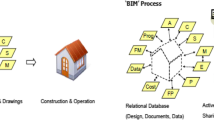Abstract
Building Information Modelling (BIM) is an intelligent digital database containing all required construction features that offer stakeholders, and AEC professionals the knowledge they can use across the project life cycle to plan, design, manage and make successful decisions. The cooperation between the teams by coordinating 3D designs through BIM is necessary for the final design to be free of clash. The literature indicates that the need for BIM has increased and that some countries have also mandated its use in their construction projects. This paper aims to investigate the root cause of clashes occurring in construction work and their quantification using building information modelling. The research method implemented in this study is the preparation of 3D architectural, structural and MEP (Mechanical, Electrical and Plumbing) Revit model and the analysis of clashes using BIM software for buildings in India. The result from the BIM software showed the different types of clashes that affect the construction mainly, hard clashes which occurs due to the intersection of the component from different disciplines, soft clashes due to lack of buffer space around equipment’s and workflow, or 4D clashes focused on the conflict between workflow and scheduling of equipment. This study concludes with the detailed quantification of clashes, their causes and impact of occurrence on building construction projects.
Access this chapter
Tax calculation will be finalised at checkout
Purchases are for personal use only
Similar content being viewed by others
References
Arayici Y, Aouad G (2011) Building information modelling (BIM) for construction lifecycle management. In: Construction and building: design, materials, and techniques, March, pp 99–117
Abanda FH, Vidalakis C, Oti AH, Tah JHM (2015) A critical analysis of building information modelling systems used in construction projects. Adv Eng Softw 90:183–201. https://doi.org/10.1016/j.advengsoft.2015.08.009
Ahuja R, Sawhney A, Jain M, Arif M, Rakshit S (2020) Factors influencing BIM adoption in emerging markets—the case of India. Int J Constr Manag 20(1):65–76. https://doi.org/10.1080/15623599.2018.1462445
Sawhney A, Singhal P (2014) Drivers and barriers to the use of building information modelling in India. Int J 3-D Inf Model 2(3):46–63. https://doi.org/10.4018/ij3dim.2013070104
Staub-French S, Khanzode A (2007) 3D and 4D modeling for design and construction coordination: issues and lessons learned. ITcon 12(Sept 2006):381–407. http://www.itcon.org/2007/26
Tommelein ID, Gholami S (2012) Root causes of clashes in building information models. In: IGLC 2012—20th conference of the international group for lean construction, 1(510)
Tixier AJP, Hallowell MR, Rajagopalan B, Bowman D (2017) Construction safety clash detection: identifying safety incompatibilities among fundamental attributes using data mining. Autom Constr 74:39–54. https://doi.org/10.1016/j.autcon.2016.11.001
Hartmann T (2010) Detecting design conflicts using building information models : a comparative lab experiment. In: Proceedings of the CIB W78 2010: 27th international conference—Cairo, Egypt, 16–18 Nov
Leite F, Akinci B (2009) Identification of data items needed for automatic clash detection in MEP design coordination: construction research congress 2009, pp. 416–425
Akponeware AO, Adamu ZA (2017) Clash detection or clash avoidance? An investigation into coordination problems in 3D BIM. Buildings 7(3):1–28. https://doi.org/10.3390/buildings7030075
Seo J-H, Lee B-R, Kim J-H, Kim J-J (2012) Collaborative process to facilitate BIM-based clash detection tasks for enhancing constructability. J Korea Inst Build Constr 12(3):299–314. https://doi.org/10.5345/jkibc.2012.12.3.299
Reddy P (n.d.) BIM for building owners and developers: making a business case for using BIM on projects
Matejka P, Sabart D (2018) Categorization of clashes and their impacts on construction projects. In: Engineering for rural development, 17, pp 827–835. https://doi.org/10.22616/ERDev2018.17.N102
Author information
Authors and Affiliations
Corresponding author
Editor information
Editors and Affiliations
Rights and permissions
Copyright information
© 2023 The Author(s), under exclusive license to Springer Nature Singapore Pte Ltd.
About this paper
Cite this paper
Gandhi, S.V., Hedaoo, N.A. (2023). Analysis of Clashes and Their Impact on Construction Project Using Building Information Modelling. In: Ranadive, M.S., Das, B.B., Mehta, Y.A., Gupta, R. (eds) Recent Trends in Construction Technology and Management. Lecture Notes in Civil Engineering, vol 260. Springer, Singapore. https://doi.org/10.1007/978-981-19-2145-2_21
Download citation
DOI: https://doi.org/10.1007/978-981-19-2145-2_21
Published:
Publisher Name: Springer, Singapore
Print ISBN: 978-981-19-2144-5
Online ISBN: 978-981-19-2145-2
eBook Packages: EngineeringEngineering (R0)




